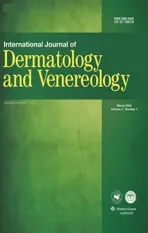Co-Infection of Chlamydia trachomatis and Neisseria gonorrhoeae on Adult Conjunctivitis:A Case Report
2020-04-03ChangHuiCaiDongXingZengShaoChunChenYuePingYin
Chang-Hui Cai, Dong-Xing Zeng, Shao-Chun Chen∗, Yue-Ping Yin∗
1Department of Outpatient, The Second People’s Hospital of Zhongshan City, Zhongshan, Guangdong 528447, China;
2Department of Ophthalmology, Zhongshan Hospital of Traditional Chinese Medicine, Zhongshan, Guangdong 528401, China;
3Reference Laboratory for STD, National Center for STD Control, Chinese Center for Disease Control and Prevention, Hospital for Skin Diseases (Institute of Dermatology), Chinese Academy of Medical Sciences and Peking Union Medical College, Nanjing,Jiangsu 210042, China.
Introduction
Chlamydia trachomatis (CT) and Neisseria gonorrhoeae(NG)infectionsarethemost prevalentsexuallytransmitted infections among adultsglobally,1 and mostcommonly cause urogenital infections but also ocular infections,which often occur in newborns but rarely in adults. We herein report such a case of adult conjunctivitis caused by CT and NG coinfection.
Case report
A 65-year-old man with a two-day history of ocular discomfort was admitted to the Zhongshan Hospital of Traditional Chinese Medicine. His main symptoms were conjunctival injection, eyelid swelling, ocular pain,photophobia,decreased visual acuity,and purulent ocular discharge in the right eye Fig. 1. Routine blood examination showed high white blood cell and neutrophil counts. Liver and kidney function were normal. He was initially diagnosed with conjunctivitis and treated with conjunctival sac and lacrimal passage irrigation,levofloxacin and tobramycin eye drops, and intravenous ceftazidime (1g three times daily).
An ocular swab was sent for laboratory diagnosis on the second day of hospitalization, and Gram-negative diplococci were found within leukocytes. Culture and antimicrobial susceptibility tests were performed. According to the established criteria, the nucleic acid amplification testing(NAAT)-confirmed NG isolate was sensitive to spectinomycin, ceftriaxone, cefixime, and azithromycin;intermediately susceptible to penicillin; and resistant to tetracycline and ciprofloxacin.2After consultation with a dermatologist, a diagnosis of gonococcal conjunctivitis was made and the patient was treated with a single 2-g intravenous dose of ceftriaxone. After 12 days of hospitalization, his symptoms slightly improved and he requested discharge from the hospital.
One month after discharge, the patient was examined during a follow-up visit. The right eye had no obvious symptoms, but the patient had moderately decreased visual acuity. The patient was asked about his epidemiological history and he reported a single episode of sexual intercourse with a female sex worker 20 days before the initial visit to the hospital. Symptoms of urethritis with purulent discharge from the penis occurred 10 days after this episode, and ocular pain developed 1 week after the urethritis.Based on this history,we inferred that the ocular infection had been self-inoculated from the genital discharge. Ocular and genital samples were collected at the follow-up visit, and CT/NG NAAT was performed.The NG NAAT was negative, but the CT NAAT was positive for both the ocular and genital samples. The CT infection was successfully treated with azithromycin (1g orally once every two days for one week).
Discussion

Figure 1. Presentation of conjunctivitis caused by Chlamydia trachomatis (CT) and Neisseria gonorrhoeae (NG). Eyelid swelling and purulent ocular discharge of the right eye.
Gonococcal conjunctivitis often occurs in newborns but rarely in adults.3The clinical manifestations of this infection are conjunctival injection, photophobia,decreased visual acuity, ocular pain, and purulent discharge.4Gonococcal conjunctivitis is highly infectious and can result in blindness if not treated properly.5It is important to inquire about the patient’s sexual history and to perform appropriate laboratory examinations in an ophthalmology clinic. This is recommended because patients may not be forthcoming about their illness and may conceal a history of prostitution, which can result in an incorrect diagnosis.In the present case,the patient did not report his sexual history or genital symptoms at his first visit to the hospital. The ophthalmologist treated the patient for typical conjunctivitis. Therefore, ophthalmologists must be vigilant for cases of conjunctivitis caused by gonococcal infection.This case emphasizes the importance of using appropriate tests (eg, CT/NG NAAT) to detect CT/NG infection in the ophthalmology clinic.
Antibiotic resistance of gonococcus is becoming a global concern6;thus,performing antimicrobial susceptibility tests and treating gonococcal conjunctivitis using appropriate antibiotics is crucial.7The Centers for Disease Control and Prevention in the United States and public health agencies in other countries recommend combined treatment with ceftriaxone and azithromycin.8-9Unfortunately, because azithromycin resistance is more common in China,ceftriaxone and spectinomycin should be recommended as first-line treatment for gonococcal conjunctivitis, and azithromycin should be added if the patient has CT/NG coinfection.10
Acknowledgments
We thank William Shafer for his valuable comments.This study was supported by grants from the Key Technology Program of Zhongshan(No.2017B1064),the Chinese Academy of Medical Sciences Initiative for Innovative Medicine (No. 2016-I2M-3-021), and the Jiangsu Natural Science Foundation (No.BK20171133).
杂志排行
国际皮肤性病学杂志的其它文章
- Chinese Guidelines for the Management of Chronic Pruritus (2018)#
- Chinese Guidelines for the Diagnosis and Treatment of Urticaria: 2018 Update#
- Guidelines for the Diagnosis and Treatment of Psoriasis in China: 2019 Concise Edition#
- Effects of Honokiol on Activation of Transient Receptor Potential Channel V1 and Secretion of Thymic Stromal Lymphopoietin in HaCaT Keratinocytes
- Pathogenesis of Photoaging in Human Dermal Fibroblasts
- Lipoid Proteinosis Due to Homozygous Deletion Mutation (c.735delTG) in the ECM1 Gene Presents with Seizures and Hoarseness but No Skin Involvement
